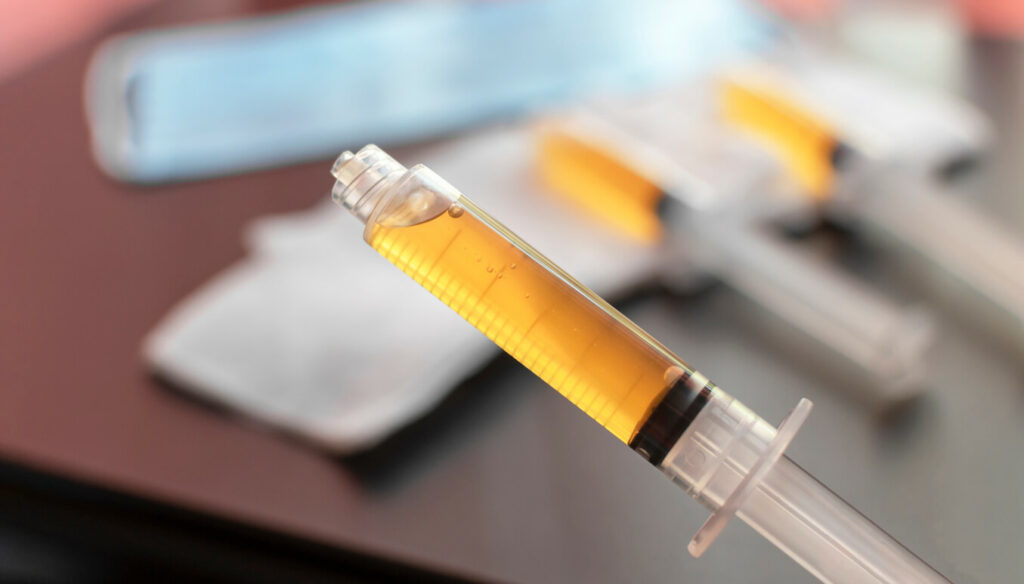
Platelet-rich plasma (PRP) therapy is a popular treatment that helps speed up healing and treats many different medical issues. But, like all medical treatments, it has its own risks and side effects. This article will give you a simple overview of these risks and side effects.
Knowing both the risks and benefits of PRP therapy can help you talk to your doctor and choose the best option for your health and well-being.
Understanding Platelet-Rich Plasma Therapy
Platelet-rich plasma therapy, or PRP therapy, involves utilizing a component of your own blood to treat a variety of issues.
In a clinical setting, providers begin the process by drawing a small amount of blood from the patient. Then, they put the blood in a centrifuge. This machine spins the blood rapidly to separate the various components or parts of the blood.
The platelet-rich plasma portion is taken out and injected into the area needing treatment.
Potential Risks of PRP Therapy
While PRP therapy has many benefits, it is important to know about the potential risks, which include:
Infection
Infection is a very rare but possible risk with any injection-based treatment. Bacteria can enter your body and cause serious issues. To reduce this risk, the practitioner must follow strict hygiene protocols. They must do so before, during, and after the procedure.
A sterile environment and thorough cleaning of the injection site are crucial. Proper hygiene procedures will almost completely eliminate the risk of infection.
Nerve Injury
Incorrectly administered injections can cause nerve damage, leading to pain, weakness, or numbness. This can delay recovery instead of speeding it up.
Healthcare providers usually receive training to avoid inflicting nerve damage. To avoid this, choose licensed medical providers who understand your body’s anatomy. Also, opt for someone who can deliver injections accurately.
Allergic Reactions
Although PRP uses your own blood, allergic reactions can still happen in rare occasions. This may be due to additives or the injection process itself. Discuss your allergy history with your healthcare provider. This way, they can take steps to prevent any reactions, if necessary.
The Benefits of PRP Therapy
Despite risks, platelet-rich plasma therapy has many benefits. It has shown positive results for various health issues.
Sports Injuries
Research shows that PRP therapy can help heal tendons, ligaments, and muscles faster. By reducing inflammation and promoting tissue repair, many individuals return to their daily activities more quickly.
Chronic Pain
PRP therapy can be a useful treatment for those with chronic pain conditions. Some examples are arthritis, tendonitis, and some types of back pain.
PRP therapy often reduces pain levels and improves daily activities. These effects can help improve a patient’s quality of life.
Cosmetic Treatments
In aesthetic medicine, PRP therapy is known for its anti-aging effects. It helps improve your skin appearance by reducing wrinkles and fine lines. PRP therapy can also help increase your skin volume and restore a natural glow. Many patients notice better skin texture and elasticity following treatment.
Who Should Avoid PRP Therapy?
Platelet-rich plasma therapy has many benefits, but it is not suitable for everyone. Here are some groups of people who should be cautious or look for alternatives:
Pregnant Women
There is not enough research on the effects of PRP therapy during pregnancy. Undergoing PRP therapy while pregnant may have unintended and unexpected effects.
Therefore, doctors may advise pregnant women to avoid PRP therapy. This way, they ensure the safety of both the mother and baby.
Cancer Patients
The growth factors in PRP could potentially stimulate cell growth, which might be harmful for those undergoing cancer treatment. Cancer patients should discuss this thoroughly with their oncologists before considering PRP therapy.
Blood Disorders
Those with blood disorders or clotting issues should be careful before trying PRP therapy. The effectiveness and safety of the treatment might be reduced if their blood does not respond well. This might lead to unsatisfactory results.
Ensuring Safe PRP Treatment
To ensure safe and effective PRP therapy, follow these key steps:
1. Choose a Qualified Provider
Pick a certified and experienced medical provider. They should have the technical skills and a deep understanding of your body’s anatomy. This allows them to minimize risks and use proper injection techniques.
2. Understand the Procedure
Discuss the entire PRP therapy process with your provider beforehand. Knowing what to expect from treatment can make you feel more comfortable and confident.
Ask any questions about the procedure, potential outcomes, and concerns you might have. It’s important that you feel comfortable about the process from beginning to end.
3. Follow Aftercare Instructions
Follow your provider’s aftercare recommendations closely. This includes any restrictions on physical activity, skincare routine, or prescribed medications.
This will help ensure a smooth recovery and better results. Not following your doctor’s post-treatment instructions may slow your recovery. It may also negate the effects of the therapy.
Quality Platelet-Rich Plasma Therapy in Wilmington, DE
PRP therapy has many benefits but also comes with some risks. To make an informed decision about your health, it is important to understand the therapy. You also need to know its uses and any possible side effects. If you are thinking about PRP therapy, consult a healthcare professional to learn more.
Do you need platelet-rich plasma therapy? Contact Delaware Back Pain & Sports Rehabilitation Centers at (302) 529-8783. Our team is dedicated to offering personalized care to meet your needs and concerns. Alternatively, you can submit an appointment request form. For your convenience, you can also visit us at our Newark, Middletown, Smyrna, Dover, and Milford locations.
We look forward to serving you!


